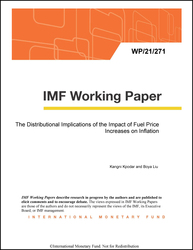
The Distributional Implications of the Impact of Fuel Price Increases on Inflation
The Distributional Implications of the Impact of Fuel Price Increases on Inflation
READ MORE...
Volume/Issue:
Volume 2021
Issue 271
Publication date: November 2021
ISBN: 9781616355197
$0.00
Add to Cart by clicking price of the language and format you'd like to purchase
Available Languages and Formats
| English |
Topics covered in this book
This title contains information about the following subjects.
Click on a subject if you would like to see other titles with the same subjects.
Inflation , Economics- Macroeconomics , Economics / General , Fuel prices , inflation , local projections , household welfare , gasoline price change , consumer price inflation , crude oil price , impulse response function , price shock , Fuel prices , Inflation , Consumer price indexes , Consumer prices , Oil prices , Global
Summary
This paper investigates the response of consumer price inflation to changes in domestic fuel prices, looking at the different categories of the overall consumer price index (CPI). We then combine household survey data with the CPI components to construct a CPI index for the poorest and richest income quintiles with the view to assess the distributional impact of the pass-through. To undertake this analysis, the paper provides an update to the Global Monthly Retail Fuel Price Database, expanding the product coverage to premium and regular fuels, the time dimension to December 2020, and the sample to 190 countries. Three key findings stand out. First, the response of inflation to gasoline price shocks is smaller, but more persistent and broad-based in developing economies than in advanced economies. Second, we show that past studies using crude oil prices instead of retail fuel prices to estimate the pass-through to inflation significantly underestimate it. Third, while the purchasing power of all households declines as fuel prices increase, the distributional impact is progressive. But the progressivity phases out within 6 months after the shock in advanced economies, whereas it persists beyond a year in developing countries.
Copyright © 2010 - 2025
Powered by:
AIDC



